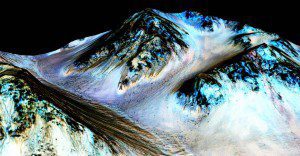
An image of Mars shows dark, 100-meter-long streaks flowing downhill that are inferred to have been formed by contemporary flowing water. The image is produced by draping an orthorectified false-color image on a digital terrain model of the same site produced by the High Resolution Imaging Science Experiment (University of Arizona). Vertical exaggeration is 1.5. (Credit: NASA/JPL/University of Arizona)
New findings from NASA's Mars Reconnaissance Orbiter (MRO) provide the strongest evidence yet that liquid water flows intermittently on present-day Mars.
Using an imaging spectrometer on MRO, researchers detected signatures of hydrated minerals on slopes where mysterious streaks are seen on the Red Planet. These darkish streaks appear to ebb and flow over time. They darken and appear to flow down steep slopes during warm seasons and then fade in cooler seasons.
Our quest on Mars has been to ˜follow the water' in our search for life in the universe, and now we have convincing science that validates what we've long suspected, said John Grunsfeld, astronaut and associate administrator of NASA's Science Mission Directorate. This is a significant development, as it appears to confirm that water”albeit briny”is flowing today on the surface of Mars.
These downhill flows, known as recurring slope lineae, often have been described as possibly related to liquid water. The new findings of hydrated salts on the slopes point to what that relationship may be to these dark features. The hydrated salts would lower the freezing point of a liquid brine, just as salt on roads causes ice and snow to melt more rapidly. Scientists say it's likely a shallow subsurface flow, with enough water wicking to the surface to explain the darkening.
Read more here.

